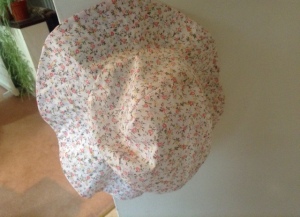The Sunhat
This post is a little different to others, as I have documented step by step how I made the sunhat seen above. Its copied from one that I already owned, but I had to create pattern templates and work out how to make it. So in many ways I am using my blog as a sewing note book. There is still more work to do; not on the sunhat itself. That’s coming on holiday with me. But there is more to do if this post is going to be of use to anyone. Anyway, read on please…………
This hat is copied from a hat that I purchased at Chatsworth House shop, many years ago – maybe 15 years ago. The official measurement is 60 cm, this being the circumference of the inner brim. I basically traced round the top and bottom and then used a compass to draw circles with the appropriate and tidy diameters. I have not yet worked out how to scale up or down.
There are 3 pattern templates:
The top – cut two. One from fabric and one lining.
The brim – cut three. Two from the fabric and one from strong interfacing.
The ‘other bit’ – cut two. One from fabric and one lining.
Whilst the top and brim are circles and could be adjusted in proportion relatively easily, the ‘other bit’ is not a rectangle, being narrower at the top than the bottom and having some curvature at the back.
Identify the circumference of the top and inner brim. Deduct the top from the inner brim, split the difference and adjust at the top of either end. Measure the height of the ‘other bit’ and ensure that the template is a consistent height, measured from the inner brim. To a large extent, the curvature was guess work, using the basic curve on my dress maker’s ruler, but it has worked well. Measure consistently from the inner brim and joint the dots to the appropriate length. The front should be cut on the straight grain.
Fold all sections into half and then quarters and mark – 4 marks per edge. These marks are used for evening up the seams when fitting together.
Make up instructions:
Making the hat is like setting in the tops of sleeves all of the time, so if you don’t like doing that, this pattern may not be for you………
1. Join the two straight edges of the fabric ‘other bit’ together at the back. Press open.
2. Using the markings on the top and top of the ‘other bit’ pin the top to the ‘other bit’. Even the fabric and pin between the marks. I recommend that you tack this in place. Sew carefully. Try on. Trim seam to 2 – 3 mm and clip seam right round. Press towards the ‘other bit’.
3. Do stages 1 and 2 above with the lining. Press up the seam allowance at the bottom of the lining
4. Using the markings on one of the inner brims and the bottom of the ‘other bit’, pin the brim to the rest of the hat. Even the fabric and pin between the marks. Tack in place. Sew carefully. Try on. Press towards the ‘other bit’. At this stage, do not trim anything.
5. Iron strong interfacing to the wrong side of the other fabric brim. Using the markings, pin the outer brims right sides together. Stitch carefully. Trim to 2 – 3 mm, clip right round and turn the right way out. Press well.
6. Stitch all three pieces of the brim together. Other options might work, but I suggest that you start by stitching a circle half way between the inner and outer brim, and then between that line of stitching and the inner and outer brims – 3 circles in all. Try to stitch evenly as this will impact the way that the brim ‘hangs’. This part is necessary in order to keep the brim even when attaching the rest of the hat. Trim the interfacing back to the inner seam line.
7. The next stage is the hardest part, especially if you don’t have any milliner’s tools. Take the lining and insert it wrong sides together, into the inner hat. Carefully line up the two tops and pin them together – just to keep them in place when you attach the two sections at the inner rim. There are probably better ways of doing this with milliner’s tools, but I don’t have any.
8. I cannot advise the best way to do this; my approach was a bit trial and indeed, error…. From the outside, pin around the join between the inner brim and the ‘other bit’ catching in the pressed up bottom of the lining. Even out the fabric, and make any adjustments to the height of the lining. Stitch by hand. I recommend stitching by hand as it allows for any slack in the lining fabric to be taken in evenly, and also, it’s easier to unpick if the resulting hat is not a good fit round the head. Press.
9. Wear-ability and travel-ability. I then washed and ironed my hat and after that, screwed it up as if it were in the bottom of my bag on a sunny day out. Ensure that it survives both treatments!
Observations
Both my prototype and final version are made from cotton or polycotton leftovers. The leftover information is good news, as there is very little outlay to make one of these. And both pass the wear-ability and travel-ability tests above. They take up very little space in my bag.
The pattern could, in theory, be used for a rain hat too. In fact the idea came about when completing my raincoat and concluding that I would still get wet, unless I had a matching hat. I will make the brim a bit bigger. Made from raincoat fabric, it won’t fold up so easily in the bottom of my shopping bag, and in fact, could be a bit of a nuisance once it’s wet.
Two potential issues with the rain hat make:
1. There is no ‘give’ in the fabric, so the circular stitching will need to be 100% even all the way round. My rain coat has set in sleeves, so this is not impossible, but could be frustrating.
2. I waterproofed some of the seams on the raincoat. Ideally both the fabric top seam and the out-facing inner brim seams should be water-proofed, but this will be difficult to do, particularly as the tape doesn’t iron on well to the inner side of the fabric. My new tailor’s ham will help! I will test.
Next steps
The information above is largely for my own purposes; to remind me what I did when I made the hats. But if someone else likes the idea and has a hat to copy, then please give it a go and follow my method.
I will try to get my pattern templates into a PDF document, which can be downloaded and copied – and will be of use if your head is the same size as mine! It might be. In general I am quite an average size.
I know that some pictures will brighten up the blog. I will take some whilst I am experimenting with the rain hat.
Grading the pattern – I can work out how to do a lot of things in sewing, but have never graded a pattern, and don’t have any training as to where to start. This is especially tricky as my ‘other bit’ has come out well, more by luck than management. Unless I find that there is serious demand I probably won’t do this…..
Ann
Jan 2016








